Program
Monday, May 26, 2014
|
8:30am – 12:00pm | Shamrock room
Real-time Skinning Tutorial
Daniel Thalmann, Zhigang Deng and Binh Le |
8:30am – 12:15pm | Plaza room
|
|
2:00pm – 2:10pm | Shamrock room
Welcome Speech
Zhigang Deng |
|
|
2:10pm - 3:20pm | Shamrock room
Keynote talk: Computer Animation of Complex Materials
Adam Bargteil |
|
|
3:20pm – 3:40pm | Coffee break
|
|
|
3:40pm – 5:30pm | Shamrock room
|
3:30pm – 5:00pm | Plaza room
|
|
6:00pm – 9:00pm | Waldorf-Astoria ballroom
Reception Dinner
|
Tuesday, May 27, 2014
|
8:30am - 9:40am | Shamrock room
|
|
|
9:40am – 10:00am | Coffee break
|
|
|
10:00am – 12:00pm | Shamrock room
|
10:00am – 12:15pm | Plaza room
|
|
2:00pm – 4:30pm | Shamrock room
|
2:00pm – 4:30pm | Plaza room
|
Wednesday, May 28, 2014
|
8:15am – 10:45am | Shamrock room
|
8:15am – 10:45am | Plaza room
|
|
10:45am – 11:00am | Coffee break
|
|
|
11:00am – 12:30pm | Shamrock room
|
|
Computer Animation of Complex Materials
| Time: | Monday, May 26, 2:10pm - 3:20pm |
| Location: | Shamrock room |
| Speaker: | Adam W. Bargteil (University of Utah) |
Abstract
A constant trend in computer graphics is toward greater sophistication and complexity. From local Phong shading to global illumination and bidirectional subsurface scattering. From static scenes to animation. From idealized fluids and solids to more sophisticated elastoplastic and viscoelastic materials. In this talk, I will discuss computer animation research into these complex materials, the challenges they present to traditional techniques, and the ways researchers have overcome these challenges. I will discuss different material models, underlying spatial discretizations, and numerical techniques.
Biography
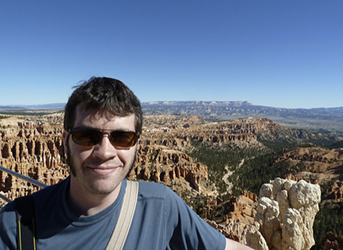 Adam W. Bargteil is an assistant professor at the University of Utah. His primary research interests lie in the area of physics-based animation. He earned his Ph.D. in computer science from the University of California, Berkeley and spent two years as a post-doctoral fellow in the School of Computer Science at Carnegie Mellon University. From 2005 to 2007, he was a consultant at PDI/DreamWorks, developing fluid simulation tools that were used in "Shrek the Third" and "Bee Movie."
Adam W. Bargteil is an assistant professor at the University of Utah. His primary research interests lie in the area of physics-based animation. He earned his Ph.D. in computer science from the University of California, Berkeley and spent two years as a post-doctoral fellow in the School of Computer Science at Carnegie Mellon University. From 2005 to 2007, he was a consultant at PDI/DreamWorks, developing fluid simulation tools that were used in "Shrek the Third" and "Bee Movie."
Physics-based Animation Sound:
Progress and Challenges
| Time: | Tuesday, May 27, 8:30am - 9:40am |
| Location: | Shamrock room |
| Speaker: | Doug L. James (Cornell University) |
Abstract
Decades of advances in computer graphics have made it possible to convincingly animate a wide range of physical phenomena, such as fracturing solids and splashing water. Unfortunately, our visual simulations are essentially "silent movies" with sound added as an afterthought. In this talk, I will describe recent progress on physics-based sound synthesis algorithms that can help simulate rich multi-sensory experiences where graphics, motion, and sound are synchronized and highly engaging. I will describe work on specific sound phenomena, and highlight the important roles played by precomputation techniques, and reduced-order models for vibration, radiation, and collision processing.
Biography
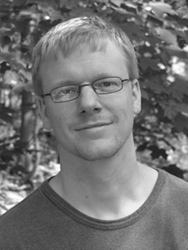 Doug L. James is Associate Professor of Computer Science at Cornell University. He holds three degrees in applied mathematics, including a Ph.D. in 2001 from the University of British Columbia. In 2002 he joined the School of Computer Science at Carnegie Mellon University as an Assistant Professor, then in 2006 he became an Associate Professor of Computer Science at Cornell University. His research interests include computer graphics, computer sound, physically based animation, and reduced-order physics models. Doug is a recipient of a National Science Foundation CAREER award, and a fellow of both the Alfred P. Sloan Foundation and the Guggenheim Foundation. He recently received a Technical Achievement Award from The Academy of Motion Picture Arts and Sciences for "Wavelet Turbulence," and the Katayanagi Emerging Leadership Prize from Carnegie Mellon University and Tokyo University of Technology.
Doug L. James is Associate Professor of Computer Science at Cornell University. He holds three degrees in applied mathematics, including a Ph.D. in 2001 from the University of British Columbia. In 2002 he joined the School of Computer Science at Carnegie Mellon University as an Assistant Professor, then in 2006 he became an Associate Professor of Computer Science at Cornell University. His research interests include computer graphics, computer sound, physically based animation, and reduced-order physics models. Doug is a recipient of a National Science Foundation CAREER award, and a fellow of both the Alfred P. Sloan Foundation and the Guggenheim Foundation. He recently received a Technical Achievement Award from The Academy of Motion Picture Arts and Sciences for "Wavelet Turbulence," and the Katayanagi Emerging Leadership Prize from Carnegie Mellon University and Tokyo University of Technology.
| Notes: |
|
Session 1: Head and Face Capture and Animation
Monday, May 26, 3:40pm – 5:30pm | Shamrock room
Session chair: Zhigang Deng
Rapid Avatar Capture and Simulation using Commodity Depth Sensors
Ari Shapiro, Andrew Feng (Institute of Creative Technologies, University of Southern California, USA), Wang Ruizhe, Hao Li (University of Southern California, USA), Mark Bolas (Institute of Creative Technologies, University of Southern California, USA), Gerard Medioni (University of Southern California, USA), and Evan Suma (Institute of Creative Technologies, University of Southern California, USA)
Interactive Model-based Reconstruction of the Human Head using an RGB-D Sensor
Michael Zollhöfer, Justus Thies, Matteo Colaianni, Marc Stamminger and Günther Greiner (FAU Erlangen-Nuremberg, Germany)
The Semantic Space for Facial Communication
Susana Castillo (Brandenburg University of Technology Cottbus-Senftenberg, Germany), Christian Wallraven (Korea University, Korea) and Douglas W. Cunningham (Brandenburg University of Technology Cottbus-Senftenberg, Gemany)
2D Expressive Speech Talking Head Based on the OCC Model of Emotions (short paper)
Paula Costa and José Mario De Martino (University of Campinas, Brazil)
Session 2: Visual and Haptic Rendering
Monday, May 26, 3:30pm – 5:00pm | Plaza room
Session chair: Doug James
Realtime Depth-of-Field Rendering Using Single-Layer Composition
Xiaoxin Fang, Bin Sheng (Shanghai Jiao Tong University, China), Wen Wu (University of Macau, Macao), Zengzhi Fan and Ma Lizhuang (Shanghai Jiao Tong University, China)
A Hybrid Level of Detail Representation for Large-Scale Urban Scenes Rendering
Shengchuan Zhou (Ocean University of China, China), Innfarn Yoo, Bedrich Benes (Purdue University, USA) and Ge Chen (Ocean University of China, China)
A Haptic-enabled Novel Approach to Cardiovascular Visualization
Shamima Yasmin (Arizona State University and University of Texas at San Antonio, USA)
Session 3: Motion Capture, Annotation, and Editing
Tuesday, May 27, 10:00am – 12:00pm | Shamrock room
Session chair: Adam Bargteil
Human Motion Retrieval Based on Freehand Sketch
Zhangpeng Tang, Jun Xiao, Yinfu Feng (Zhejiang University, China) and Xiaosong Yang (Bournemouth University, UK)
A Genetic Algorithm Approach to Human Motion Capture Data Segmentation
Na Lv, Yan Huang (Shandong University, China), Zhiquan Feng (Jinan University, China) and Jingliang Peng (Shandong University, China)
Combining Inverse Blending and Jacobian-based Inverse Kinematics to Improve Accuracy in Human Motion Generation
Liang Zhang and Guido Brunnett (Chemnitz University of Technology, Germany)
Real-time Motion Data Annotation via Action String
Tian Qi, Jun Xiao, Yueting Zhuang, Hanzhi Zhang (Zhejiang University, China), Xiaosong Yang, Jianjun Zhang (Bournemouth University, UK) and Feng Yinfu (Zhejiang University, China)
Session 4: Motion Synthesis
Tuesday, May 27, 10:00am – 12:15pm | Plaza room
Session chair: Pierre Poulin
Human Motion Variation Synthesis with Multivariate Gaussian Processes
Liuyang Zhou (City University of Hong Kong, Hong Kong), Lifeng Shang (Noah’s Ark Lab, Huawei, Hong Kong), Hubert P. H. Shum (Northumbria University, UK) and Howard Leung (City University of Hong Kong, Hong Kong)
Interactive Motion Synthesis with Optimal Blending
Masaki Oshita (Kyushu Institute of Technology, Japan)
Bulging-free Dual Quaternion Blend Skinning
Youngbeom Kim and Junghyun Han (Korea university, Korea)
Position-Based Rigid Body Dynamics
Crispin Deul, Patrick Charrier and Jan Bender (Technische Universität Darmstadt, Germany)
Physics-based Motion Control through Hierarchical Neuroevolution (short paper)
Mart Hagenaars, Nicolas Pronost and Arjan Egges (Utrecht University, Netherlands)
Session 5: Crowd Simulation
Tuesday, May 27, 2:00pm – 4:30pm | Shamrock room
Session chair: Daniel Thalmann
Hierarchical Structures for Collision Checking between Virtual Characters
Sybren Stüvel (Universiteit Utrecht, Netherlands), Nadia Magnenat-Thalmann, Daniel Thalmann (Nanyang Technological University , Singapore), Arjan Egges and Frank van der Stappen (Universiteit Utrecht, Netherlands)
Deformable Polygonal Agents in Crowd Simulation
Thomas Pitiot, David Cazier, Thomas Jund, Pierre Kraemer and Arash Habibi (Laboratoire ICube, France)
Flock Morphing Animation
Xinjie Wang (Zhejiang University, China), Linling Zhou (Zhejiang University, China), Zhigang Deng (University of Houston, USA) and Xiaogang Jin (Zhejiang University, China)
Interactive Crowd Simulation on Mobile Devices in an Augmented Reality Environment (short paper)
Aytek Aman, Ates Akaydin and Ugur Gudukbay (Bilkent University, Turkey)
A Layered Communication Model for Agents in Virtual Crowds (short paper)
Kurtulus Kullu and Ugur Gudukbay (Bilkent University, Turkey)
Synthetic Vision-based Crowd Simulation: Reactive vs. Reactive Planning Approaches (short paper)
Teófilo B. Dutra (Universidade Federal do Ceará, Brazil), Gurvan Priem (Supélec, France), Joaquim B. Cavalcante-Neto, Creto A. Vidal (Universidade Federal do Ceará, Brazil) and Julien Pettré (INRIA, France)
Illusive Crowd (short paper)
Oner Barut (Hacettepe University, Turkey), Murat Haciomeroglu (Gazi University, Turkey) and Cumhur Ozcan (Hacettepe University, Turkey)
Session 6: Behavioral Animation
Tuesday, May 27, 2:00pm – 4:30pm | Plaza room
Session chair: Zhigang Deng
A Personality Model for Animating Heterogeneous Traffic Behaviors
Xuequan Lu (Zhejiang University, China), Zonghui Wang (Zhejiang University, China), Mingliang Xu (Zhengzhou University, China), Wenzhi Chen (Zhejiang University, China) and Zhigang Deng (University of Houston, USA)
Modeling Social Behaviors in an Evacuation Simulator
Mei Ling Chu, Paolo Parigi, Jean-Claude Latombe and Kincho Law (Stanford University, USA)
An All-in-one Efficient Lane-changing Model for Virtual Traffic
Hua Wang (University of Chinese Academy of Sciences, China), Tianlu Mao (Institute of Computing Technology, Chinese Academy of Sciences, China), Xingchen Kang (University of Chinese Academy of Sciences, China), and Zhaoqi Wang (Institute of Computing Technology, Chinese Academy of Sciences, China)
Towards A Data-driven Approach to Scenario Generation for Serious Games
Linbo Luo, Haiyan Yin, Wentong Cai (Nanyang Technological University, Singapore), Michael Lees (University of Amsterdam, Netherlands), Nasri Othman (Institute of High Performance Computing, Singapore) and Suiping Zhou (Middlesex University, UK)
Populating Semantic Virtual Environments
Cameron Pelkey and Jan Allbeck (George Mason University, USA)
Session 7: Deformations and Meshes
Wednesday, May 28, 8:15am – 10:45am | Shamrock room
Session chair: Binh H. Le
Hierarchical Mesh Deformation with Shape Preservation
Yong Zhao (Ocean University of China, China)
Real-time Physical Deformation and Cutting of Heterogeneous Objects via Hybrid Coupling of Meshless Approach and Finite Element Method
Chen Yang, Shuai Li, Lili Wang, Aimin Hao (Beihang University, China) and Hong Qin (Stony Brook University, USA)
Macroscopic and Microscopic Deformation Coupling in Up-sampled Cloth Simulation
Shunsuke Saito (Waseda University, Japan), Nobuyuki Umetani (University of Tokyo, Japan) and Shigeo Morishima (Waseda University, Japan)
Adaptive Skeleton-driven Cages for Mesh Sequences
Xue Chen and Jieqing Feng (Zhejiang University, China)
Virtual Fitting: Real-Time Garment Simulation (short paper)
Xuaner Zhang and Lam Yuk Wong (Rice University, USA)
Towards Cloth-Manipulating Characters (short paper)
Eder Miguel (URJC Madrid, Spain), Andrew Feng and Ari Shapiro (Institute of Creative Technologies, University of Southern California, USA)
Session 8: Natural Phenomena
Wednesday, May 28, 11:00am – 12:30pm | Shamrock room
Session chair: Guoning Chen
Real-Time Simulation of Ductile Fracture with Oriented Particles
Min Gyu Choi (Kwangwoon University, Korea)
Turbulence Synthesis for Shape-Controllable Smoke Animation
Ben Yang and Xiaogang Jin (Zhejiang University, China)
Visual Fluid Animation via Lifting Wavelet Transform (LWT)
Shiguang Liu (Tianjin University, China), Yixin Xu (Tianjin University, China), Junyong Noh (KAIST, Korea) and Yiying Tong (Michigan State University, USA)
Session 9: Social Agents
Wednesday, May 28, 8:15am – 10:45am | Plaza room
Session chair: Xiaogang Jin
Virtual Coaches over Mobile Video (short paper)
David Krum, Sin-Hwa Kang and Mark Bolas (Institute of Creative Technologies, University of Southern California, USA)
Collaborative Virtual Training with Physical and Communicative Autonomous Agents
Thomas Lopez (INSA de Rennes, INRIA, France), Pierre Chevaillier (ENIB, France), Valérie Gouranton (INSA de Rennes, INRIA, France), Paul Evrard (CEA List, France), Florian Nouviale (INSA de Rennes, INRIA, France), Mukesh Barange (ENIB, France), Rozenn Bouville-Berthelot (INSA de Rennes, INRIA, France) and Bruno Arnaldi (INSA de Rennes, INRIA, France)
Assistant Agents to Advice Users in Hybrid Structured 3D Virtual Environments
Pablo Almajano (IIIA-CSIC, Universitat de Barcelona, Spain), Maite Lopez-Sanchez, Inmaculada Rodríguez (Universitat de Barcelona, Spain) and Tomas Trescak (University of Western Sydney, Australia)
A Model for Social Spatial Behavior in Anthropomorphic Virtual Characters
Nahid Karimaghalou, Ulysses Bernardet and Steve Dipaola (Simon Fraser University, Canada)
Corruptible Social Agents
J. Octavio Gutierrez-Garcia (Instituto Tecnologico Autonomo de Mexico, Mexico) and Luis-Felipe Rodríguez (Instituto Tecnológico de Sonora, Mexico)
AIDA: An Avatar-Supported Multimodal Dialogue System (short paper)
Arthur Niswar, Rafael Banchs, Ridong Jiang and Seokhwan Kim (Institute for Infocomm Research, Singapore)
Structured Meshing:
Theory, Applications, and Evaluation
| Time: | Monday, May 26, 8:30am – 12:30pm |
| Location: | Plaza room |
8:30am-9:15am |
Invited Talk I
The topology of 3D frame fields: what it might look like and what we might be able to do with it? |
9:15am-10:15am |
Section I: Theory and Techniques of Structured Meshing
Section chair: Guoning Chen A New Polycube Shape Optimization Algorithm for Hex Mesh Generation Adaptive and Anisotropic T-mesh Generation from Cross Field Truncated Hierarchical Catmull-Clark Subdivision with Local Refinement for Arbitrary Topology |
10:15am-10:30am |
Coffee break
|
10:30am-11:15am |
Invited Talk II
Analysis-suitable Geometry and Isogeometric Analysis |
11:15am-12:15pm |
Section II: Evaluation and Applications of Structured Meshes
Section chairs: Jin Huang and Jessica Zhang An Evaluation of The Quality of Hexahedral Meshes Via FEA-based Simulations Fluid Simulation on Unstructured Quadrilateral Surface Meshes A Finite Element Pelvic Model for Better Understanding of Pelvic Floor Dysfunctions |
Real-time Skinning and Deformation
| Time: | Monday, May 26, 8:30am – 12:00pm |
| Location: | Shamrock room |
| Instructors: |
Daniel Thalmann (Nanyang Technological University, Singapore) Zhigang Deng (University of Houston, USA) Binh Le (University of Houston, USA) |
Introduction
Skinning is the process of generating surface deformation of the character from a low-dimensional controller. This technique is a standard way to animate characters, especially in real time applications such as games or virtual worlds. This tutorial reviews fundamental topics on skinning including: skeleton-based deformation, free form deformation, linear blend skinning and non-linear skinning methods, as well as advanced topics on: anatomically-based methods, skinning from examples, and skinning on GPU.
Course Schedule
Session #1 (45 minutes): Fundamentals of Skinning (Thalmann)
- Skinning Introduction
- Skeleton-based Deformations
- Sub-space Deformations
- Skin Mapping – deformations by cross sections, implicit surfaces (metaballs), FFDs
- Anatomically-based Methods
Session #2 (1.5 hours): Advanced Skinning (Deng and Le)
- Skinning from Examples and Skinning Decomposition
- Skinning Correction, Blend Shape and Pose-space Deformation
- Non-linear Skinning: Spherical Blending, Log-matrix Blending, Dual-quaternion
- Skinning on GPU
- Skinning Weights Reduction and Compression
Prerequisites
General knowledge of linear algebra, numerical analysis, and GLSL programming skills.
Intended Audience
Developers and researchers who are interested in learning more about skinning, especially about its real-time applications.
Biographies
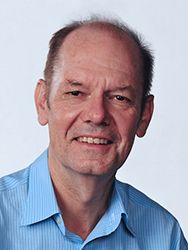 Daniel Thalmann is with the Institute for Media Innovation at the Nanyang Technological University in Singapore. He is a pioneer in research on Virtual Humans. His current research interests include Real-time Virtual Humans in Virtual Reality, crowd simulation, and 3D Interaction. Daniel Thalmann has been the Founder of The Virtual Reality Lab (VRlab) at EPFL, Switzerland, Professor at The University of Montreal and Visiting Professor/ Researcher at CERN, University of Nebraska, University of Tokyo, and National University of Singapore. Until October 2010, he was the President of the Swiss Association of Research in Information Technology and one Director of the European Research Consortium in Informatics and Mathematics (ERCIM). He is coeditor-in-chief of the Journal of Computer Animation and Virtual Worlds, and member of the editorial board of 6 other journals. Daniel Thalmann was member of numerous Program Committees, Program Chair and CoChair of several conferences including IEEE VR, ACM VRST, and ACM VRCAI. Daniel Thalmann has published more than 500 papers in Graphics, Animation, and Virtual Reality. He is coeditor of 30 books, and coauthor of several books including 'Crowd Simulation' (second edition 2012) and 'Stepping Into Virtual Reality' (2007), published by Springer. He received his PhD in Computer Science in 1977 from the University of Geneva and an Honorary Doctorate (Honoris Causa) from University Paul- Sabatier in Toulouse, France, in 2003. He also received the Eurographics Distinguished Career Award in 2010 and the 2012 Canadian Human Computer Communications Society Achievement Award.
Daniel Thalmann is with the Institute for Media Innovation at the Nanyang Technological University in Singapore. He is a pioneer in research on Virtual Humans. His current research interests include Real-time Virtual Humans in Virtual Reality, crowd simulation, and 3D Interaction. Daniel Thalmann has been the Founder of The Virtual Reality Lab (VRlab) at EPFL, Switzerland, Professor at The University of Montreal and Visiting Professor/ Researcher at CERN, University of Nebraska, University of Tokyo, and National University of Singapore. Until October 2010, he was the President of the Swiss Association of Research in Information Technology and one Director of the European Research Consortium in Informatics and Mathematics (ERCIM). He is coeditor-in-chief of the Journal of Computer Animation and Virtual Worlds, and member of the editorial board of 6 other journals. Daniel Thalmann was member of numerous Program Committees, Program Chair and CoChair of several conferences including IEEE VR, ACM VRST, and ACM VRCAI. Daniel Thalmann has published more than 500 papers in Graphics, Animation, and Virtual Reality. He is coeditor of 30 books, and coauthor of several books including 'Crowd Simulation' (second edition 2012) and 'Stepping Into Virtual Reality' (2007), published by Springer. He received his PhD in Computer Science in 1977 from the University of Geneva and an Honorary Doctorate (Honoris Causa) from University Paul- Sabatier in Toulouse, France, in 2003. He also received the Eurographics Distinguished Career Award in 2010 and the 2012 Canadian Human Computer Communications Society Achievement Award.
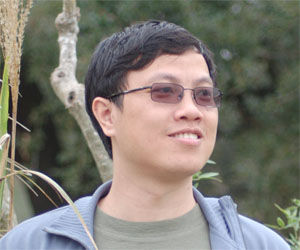 Zhigang Deng is an Associate Professor of Computer Science at University of Houston (UH) and the Founding Director of the UH Computer Graphics and Interactive Media Lab. His research interests are in the broad areas of computer graphics, computer animation, human computer interaction, virtual human modeling and animation, and visual computing for biomedical applications. He is the recipient of UH Teaching Excellence Award, Google Faculty Research Award, UHCS Faculty Academic Excellence Award, Texas NHARP Award, NSFC Overseas and Hong Kong/Macau Young Scholars Collaborative Research Award, and two best paper award nominees (ICRA 2012 and BioRob 2012). Besides the CASA 2014 general co-chair, He currently serves as the Associate Editor of Computer Graphics Forum (since 4/2014), Computer Animation and Virtual Worlds Journal (Wiley), ACM Computer In Entertainment, and other journals. Zhgang Deng earned Ph.D. in Computer Science at the Integrated Media System Center (NSF ERC) and Department of Computer Science at the University of Southern California in 2006. He also completed B.S. degree in Mathematics from Xiamen University (China), and M.S. in Computer Science from Peking University (China). Over the years, he has worked at the Founder Research and Development Center (China) and AT&T Shannon Research Lab.
Zhigang Deng is an Associate Professor of Computer Science at University of Houston (UH) and the Founding Director of the UH Computer Graphics and Interactive Media Lab. His research interests are in the broad areas of computer graphics, computer animation, human computer interaction, virtual human modeling and animation, and visual computing for biomedical applications. He is the recipient of UH Teaching Excellence Award, Google Faculty Research Award, UHCS Faculty Academic Excellence Award, Texas NHARP Award, NSFC Overseas and Hong Kong/Macau Young Scholars Collaborative Research Award, and two best paper award nominees (ICRA 2012 and BioRob 2012). Besides the CASA 2014 general co-chair, He currently serves as the Associate Editor of Computer Graphics Forum (since 4/2014), Computer Animation and Virtual Worlds Journal (Wiley), ACM Computer In Entertainment, and other journals. Zhgang Deng earned Ph.D. in Computer Science at the Integrated Media System Center (NSF ERC) and Department of Computer Science at the University of Southern California in 2006. He also completed B.S. degree in Mathematics from Xiamen University (China), and M.S. in Computer Science from Peking University (China). Over the years, he has worked at the Founder Research and Development Center (China) and AT&T Shannon Research Lab.
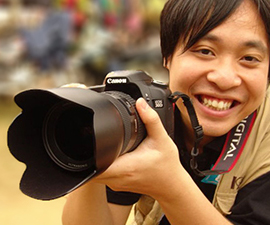 Binh Le is a PhD Candidate at the department of Computer Science at the University of Houston (expected to receive his PhD in 2014 Spring). He received B.S. in Computer Science at the Vietnam National University in 2007. He is the associate director of the Computer Graphics and Interactive Media Lab at the University of Houston. His research interests include computer graphics, and computer animation, and computer vision. He is the recipient of the Vietnam Education Foundation Fellowship, the UH Friends of NSM Fellowship, and the UHCS Best PhD Student Award. He is also the local arrangement co-chair of the CASA 2014.
Binh Le is a PhD Candidate at the department of Computer Science at the University of Houston (expected to receive his PhD in 2014 Spring). He received B.S. in Computer Science at the Vietnam National University in 2007. He is the associate director of the Computer Graphics and Interactive Media Lab at the University of Houston. His research interests include computer graphics, and computer animation, and computer vision. He is the recipient of the Vietnam Education Foundation Fellowship, the UH Friends of NSM Fellowship, and the UHCS Best PhD Student Award. He is also the local arrangement co-chair of the CASA 2014.
